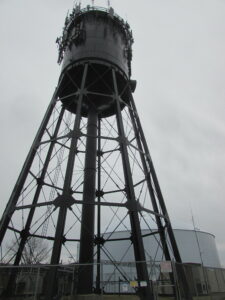
MARLBOROUGH – At a height of 1500 feet, Sligo Hill is the tallest point in Marlborough. Visible from miles around, the cylindrical water tower sitting on top is riveted to eight diagonally-braced legs. Neither woodland nor buildings blocks seeing Boston Harbor and Mount Wachusett.
In 1675 John Bowker from England purchased most of the land here, thus it was called Bowker Hill. About a hundred years later, Lieutenant Ephraim Barber, a clockmaker, bought a parcel on the highest point of the hill. Ella A. Bigelow wrote in her “Historical Reminiscences of Marlborough,” that Barber often said that he “could get as near Heaven as any person on his own land.”
She also stated that “a lovely view is always before the visitor, and the most exquisite sunsets to be enjoyed. Marlborough has the beauty of hill and dale, and from Mt. Sligo, Mt. Pleasant, Boyds, Prospect, West or Chestnut Hills, you will ever find stretching out before you as pretty a picture as anywhere to be found.”
In agreement is Henry David Thoreau, who wrote: “Yonder on that hill is Marlborough, a town which in autumn, at least when I visited it, wears a rich appearance of rustic plenty and comfort―ample farms, good houses, profuse apple heaps, pumpkin mountains in every enclosure, orchards left ungathered…”
The name “Sligo” belongs to a picturesque place in Ireland. Its hills, pastures, streams, ponds, oak, larches, beech and flowers perhaps inspired the name bestowed by early settlers. Immigrants came from the British Isles, followed by French Canadians in the mid-1800s. Most arrivals worked in enormous shoe factories springing up throughout Marlborough, and lived in densely populated neighborhoods on French Hill.
Fire protection was of great concern considering the growth of multi-storied wooden buildings, mechanical factory parts and hay for livestock. Located on top of the hill, Sligo Reservoir was small. Lake Williams, formerly called Gates Pond, could not pump much up hill.
The Department of Water launched its first large-scale municipal project. City engineer B.R.Felton designed a tank to hold 200,000 gallons of water at the top of Sligo Hill, where its high altitude utilized gravity to disperse water through lower pipes. Lake Williams below was too low.
By making the tank round, even pressure ensured that its walls would not cave in from outside winds or heavy rains. In 1895 the Chicago Bridge and Iron Company finished building the original tank. Water department workers connected three miles of pipes leading to the community’s hydrants.
For a week before Marlborough’s 250th anniversary celebration in 1910, lights decorating the standpipe attracted far away guests when electricity was a new invention. Charlotte Howe Stevens donated nine acres of her land on Sligo Hill for the Stevens Howe Playground, named for both her husband and father, the City’s first mayor. A stone monument by a flat playing field there honors Angelo “Angie” Martino, a caretaker who served Marlborough for 41 years.
Although the Sligo Hill Standpipe stopped supplying drinking water to the city in the 1960s, it remains a testament to early industrial engineering. There are few cylindrical water tanks like this still standing.











